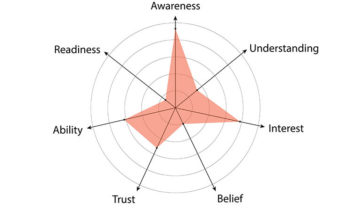Why the Sales Funnel No Longer Works
My flight just climbed out of LaGuardia. The chime signals it’s okay to power up my laptop. I’m flying home from New York where I had the opportunity to co-present to the Association of National Advertisers.
In one of my slides, I asserted that the sales funnel is inappropriate for professional services. My proposition created quite a stir. Turns out the sales funnel is central to the way most people think about how to acquire new customers.
The sales funnel model causes otherwise smart people to do the wrong thing when trying to drive business development.
Now, I’d like to go further. The idea of a sales funnel is not just unhelpful in the world of professional services, the sales funnel is a distorted and misleading mental model. The sales funnel model causes otherwise smart people to do the wrong thing when trying to drive business development.
The Ubiquitous Sales Funnel
You know the sales funnel. Everyone does, and that is part of the problem.
At the wide end of the funnel are prospective customers who are believed to be primed to buy our product. Leads are vetted. The uninterested are culled. The rest are pre-qualified, pitched, and (hopefully) closed over time.

The ubiquitous sales funnel has myriad variants.
This funnel has dozens, even hundreds, of variations. The gist of is always the same, however. Selling is deemed to be a numbers game based upon simple math:
Number of leads × Yield rate = Number of new accounts
Selling is viewed by many organizations almost as a manufacturing process. It’s managed in a similar fashion with internal metrics, reports, and meetings. The sales funnel approach may be useful for products with a high volume of prospective customers. It’s not terribly helpful when you offer credence goods or when the entire universe of those you wish to serve may be represented by a few dozen organizations.
When selling consulting or professional services, the goal is not to identify prospects and process them like corn flakes. The objective is to identify a community and position yourself to serve that community over time.
When selling consulting or professional services, the goal is not to identify prospects and process them like corn flakes. The objective is to identify a community and position yourself to serve that community over time.
The Arithmetic of Yield
When managing sales, traditional sales funnel theory tells us to measure yield from one step to the next:
- 20 of 100 leads result in an initial meeting (a 20% yield).
- Half of those meetings lead to an opportunity to make a proposal (a 50% yield).
- 2 of 10 proposals yield a sale (a 20% yield).
- So, the overall lead-to-sales yield is 2% (20% × 50% × 20% = 2%).
The trick—per sales funnel logic—is to track and improve those yields over time. That leads to the second half of how salespeople are taught to sell everything from railcar loads of coal to missile defense systems: the tactics used to move from one step to the next. Given the linear process implied, if you can move your first meeting rate from 20% to 30%, you can increase your new accounts per 100 leads from 2 to 3. It is just simple math.
So—and this is the question that sales trainers make their money on—how can you increase your yields? If you have ever been exposed to software, hardware, commodity, consumer product or OEM sales, you’ve likely heard of the following:
- Neil Rackham’s SPIN selling or the consultative sale (they are largely the same)
- Miller and Heiman’s Strategic Selling
- Mike Bosworth’s Solution Selling
- Xerox’s Needs Satisfaction Selling
- Corporate Executive Board’s Challenger Sale
All of these approaches are about how to choreograph movement from one level of the funnel to the next by improving yields.
Fishing for Clients
Like a canoe moving down a swift river, most sales systems—from the consultative sale (ask lots of questions) to the challenger sale (disrupt how your client thinks about their problem)—follow a similar path. Each might hew to the left bank or the right. They might stop to fish an eddy below a riffle or wait to troll in the deeper waters below the dam. Nevertheless, they are all going downstream in the same direction. They all purport to answer four questions:
- Where should one fish?
- What bait should one use?
- How does one hook a fish?
- What is the best way to land a fish?
Where Should One Fish?
“Start with quality leads,” sales trainers tell us. Know who might buy your product and who in the company is the decision-maker. Gather intelligence. Ideally, interview someone who used to work at the target company. The object here is not complicated. You are trying to amass a list of human beings you might call on who would be in a position to authorize the purchase of your product.
For extra credit, keep track of the source of your leads. Is there a fishing guide whose advice generally leads to a stringer heavy with fish? Pay more attention to her in the future.
To be really current, troll the waters of the internet with content. Instead of gathering leads, attract “fish” with lead magnets.

The standard approach to sales suggests that business development is akin to fishing for clients.
What Bait Should One Use?
The operative word here is “conversion.” Convert leads to a chance to speak with someone. Send an email solicitation. Alternatively, leave a voicemail and follow-up with an email that references a warm referral. Maybe your process is automated. Potential customers register online to speak with a representative or receive a free trial. The goal is the same: schedule time for a meeting. The more meetings, the better.
How Does One Hook a Fish?
This is where sales consultants kick into high gear. To them, it’s all about the “art” of presentation.
You hook clients by feel, one finger on the line and a quick flick of the wrist at just the right moment. Generally, the advice is to mix questions with assertions.
Questions allow the salesperson to show interest and empathy for the customer. They also reveal valuable clues to guide your proposed solutions. The goal is to get a customer to express a “felt need” for which the salesperson can propose a solution.
At the same time, a salesperson wants to find opportunities to assert their knowledge of the company and the industry. That way, the salesperson can demonstrate domain expertise and establish her authority. Consequently, the salesperson should not be afraid to proffer a point of view and frame a customer’s muddy challenges in a clear way that suggests why the salesperson’s solution is such a great fit. This is the point when the salesperson talks about features and attributes. They hand out samples to touch and feel and put slides on the wall that included comparative grids.
Selling is a conversation. Maybe you start out with questions and then make an assertion. The customer asks you a question. You answer, and the client makes an assertion. However, it’s deemed to be a conversation that is guided artfully by the salesperson.
What is the Best Way to Land a Fish?
Netting fish out of the water is underappreciated in fishing but not in sales. Maybe this because you can tell your spouse that the fish that got away was HUGE and they believe you. In sales, though, there is no catch and release. That fact predisposes us to be receptive to the purported art of closing the deal. The most famous of closing techniques is the trial close. “Sounds good. Let me run out to the car and get my order forms.” You’re doing everything short of saying, “We have a sale, right?”
Why the Funnel Doesn’t Work for Professional Services
We know that consulting and professional services are sold differently than products. Expert services are sold on reputation, referral, and relationships, not features or attributes.
- The number of relevant leads is limited.
- The duration of relationships is often long.
- Measurable doesn’t mean important.
- Business life is full of cultivated serendipity.
- There’s more than one progression.
- The super-salesperson is a myth.
The Number of Relevant Leads is Limited
If you are selling accounting software to businesses having less than $50 million in revenues, you can be pretty sure that a lifetime spent pitching software will not exhaust the global supply of potential customers. On the other hand,
- If you sell predictive analytics services to commercial banks in the U.S., you currently have 6,799 potential customers (half the number there were 50 years ago).
- If you design currency hedging strategies for reinsurance companies with a $1 billion in premiums written, you have 37 potential clients.
You might be thinking such segments are too small to serve, but you’d be wrong. Thousands of consultants and professional services practitioners “own” a focused segment. They cover it up with bespoke service and are compensated handsomely for their expertise.
Look no further than the “Big Four” accounting firms. Their audit services are laser-focused on the Fortune 500. Roughly speaking, each firm has a 25% market share. If you have 125 audit clients, an incremental dozen is meaningful.
Globalization encourages specialization. It’s increasingly likely that the number of prospective clients for your firm or practice is relatively limited. You’d be wise not to churn and burn your way through them.
The Duration of Relationships is Often Long
Read sales training advice for product salespeople and it will tell you to read your prospect like a poker player might read her opponents. By closely observing your potential customers’ tells, you can determine if they are buyers, have objections which can be met, have objections which are a smokescreen for “real” objections, or if they are a “no”. In the case of a no, the purported best practice is to move on. After all, there is no reason for wasting time on a prospect who isn’t going to buy.
But, that’s not how it works in consulting and professional services.
My colleagues and I sat in on a Big Four partners’ meeting where their best rainmakers shared the advice they would give to young professionals. They said, “Make friends on engagements when you are young because the people you get to know at client companies will grow up and be decision makers. Stay in touch.” This is a decidedly different perspective—looking at a lead as a relationship to be cultivated over a lifetime.
Make friends on engagements when you are young because the people you get to know at client companies will grow up and be decision makers. Stay in touch.
In contrast, when the “financial advisors” in the movie, Margin Call, were dialing the phones to sell penny stocks, they didn’t start over on a page when they got through with it. They were like sharks moving through the water—never stopping, never blinking, always moving and looking for something new to eat.

Professional sales prospects aren’t food for hungry sharks.
That might work for someone selling gym memberships, but not for those of us trying to engage with new clients. Successful practice leads in consulting and professional services firms are more like farmers cultivating their forty acres. They are careful with every relationship, knowing that if those relationships are treated well over time, they can sustain life.
Measurable Doesn’t Mean Important
Recall the parable of the drunk who looks for his lost keys in the light below a streetlamp. When asked why he is focused on such a small area, he answers, “Because that’s where I can see.”

Like the proverbial drunk searching for his keys under the light of a streetlamp, we tend to pay attention to what is easily measured.
There’s an implicit choice being made by measuring yield just because it’s available to measure. Instead of measuring how many opportunities led to projects, a better measure might be “How deeply did you connect philosophically, intellectually and socially with a key executive you met at a conference?” That’s not nearly as easy to measure as “What percentage of appointments did you set on those leads we purchased?” but it may be more strongly correlated with increased revenues per consultant over time.
Business Life is Full of Cultivated Serendipity
Do good work for a client. Stay in touch. Have dinner and talk shop when you are in town. Be helpful—even when you are not under contract. These are the sorts of actions that maintain and deepen relationships. They are the throne on which positive word-of-mouth marketing sits.
Consider the following series of events in which a guy you meet on the soccer pitch turns into an introduction:
- You met a person who knew your sister-in-law. Later, you dropped an email to your sister-in-law to say you had met her friend.
- Your email reminds your sister-in-law that she just learned her son’s soccer coach was two years ahead of you at business school.
- Your sister-in-law introduces you to your fellow alum the following Saturday at soccer practice when you happen to stop by. You exchange small talk. During goodbyes, he mentions he’s headed to Singapore to speak at a conference.
- You check out your new acquaintance’s LinkedIn profile on your phone. You deduce that his talk in Singapore is likely to be on how digital technologies are transforming intellectual property management.
- Coincidentally, you just received a letter from Paul Hastings, the law firm, saying they are abandoning their intellectual property practice. That has you hunting for a new IP attorney.
- You ping your globetrotting friend asking whether he can refer you to new IP counsel. He says he knows a good sole practitioner who spun out of a large firm.
- Ten minutes later he writes you saying he checked you out on LinkedIn while sitting at the gate and noticed you do work with manufacturing companies to outsource facilities management. As fate would have it, he has a client who just hired a new CEO who is talking about focusing on core competencies. Would you be open to being introduced to the client’s head of manufacturing?
Here’s the thing: every one of your new clients is probably featured in similar shaggy dog stories. In contrast to your experience, the sales funnel model says you call on a prospect, make a pitch, and close the deal. Bada bing, bada boom. The typical funnel-based sales model doesn’t appreciate shaggy dogs.
There’s More Than One Progression
The sales funnel assumes that you first create awareness, then uncover interest and desire, and finally that you catalyze action. (This is the “AIDA” model of client engagement to which you were exposed in undergraduate marketing.) But what if you stumble on desire first which causes you to get yourself in front of a prospect (awareness)? You decide to do a pilot (action) that leads you to lift the stone on what turns out to be their real problem (interest).

Like chord progressions on a guitar, gratifying relationships can unfold in many different ways.
Relationships for consultants and professional service providers almost never unfold serially. Cultivating a relationship is like creating a chord progression on a guitar. Do you need to play the G chord before the D7 to make music? No. You can, but it’s also possible to begin a beautiful piece from the D7 chord.
The Super-Salesperson is a Myth
Focusing on the meeting and the art of the sale suggests that some people have some special way with others that causes the target of their affection to bend to their wills. Like Svengali in George Du Maurier’s novel, Trilby, super-salespeople are able to dominate and manipulate their subjects and cause them to do things they might not otherwise choose to.
Not only is this creepy, it doesn’t square with our experience. First, salespeople who are thought to be really good with people often come off as just inauthentic, oily and unctuous. Call it the backfire effect. Second, we all know of experts who are just terrible with people but who have a line out the door.
In consulting and professional services, substance matters. An expert who’s known to be worth their weight in gold needn’t be a charmer. It’s nice if they’re nice, but it isn’t a requirement.
Get a Copy of this Article
No, we’re not going to ask you for your email address.




